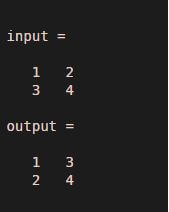

The randperm function calls rand and therefore changes rand s seed value. The algorithm can also be amended to iterate from left to right, if that is more convenient. p randperm(n) returns a random permutation of the integers 1:n.If that is unreasonable in your programming language, you may amend the algorithm to return the shuffled items as a new array instead.


Let j = random integer in range 0 ≤ i swap items with items generates a row vector with n elements that are random permutation of. Given an array items with indices ranging from 0 to last, the algorithm can be defined as follows (pseudo-code): Edited: Tomas on To shuffle vectors without saving them to a variable first, e.g. A vector in which the first element is x0, the last element is xn and the number. Implement the Knuth shuffle for an integer array (or, if possible, an array of any type). the Fisher-Yates shuffle) is an algorithm for randomly shuffling the elements of an array. I’m open to new opportunities – consulting, contract or full-time – so let’s have a chat on how we can work together!Ĭome follow me on Twitter: other contact details can be found here.You are encouraged to solve this task according to the task description, using any language you may know. Knuth_shuffle (x ) R fisheryatesknuthshuffle =2) MatLab function list = knuthShuffle (list ) for i = (numel (list ):- 1: 2 ) j = floor ( i* rand ( 1 ) + 1 ) %Generate random int between 1 and i %Swap element i with element j.Įnd end Python from random import randrangeįor i in range ( len (x )- 1, 0, - 1 ): Even though it is obviously preferable to use internal shuffling if its available, it is still very illuminating to see how the modern Fisher-Yates algorithm could be implemented in your language of choice.Ĭ++ #include #include int main ( ) ]]]] (Note that if the language has an internal shuffle, this is typically mentioned first. Thanks to the Rosetta code, here is the modern Fisher-Yates algorithm in some of the common languages. The range of the random integer must be within the range of the original x vector so that it is interpolating, not extrapolating (e.g., in the following example. Note that Sedgewick is the author of one of the most readable and respected books on this topic! Over 900 pages of amazing content all for free!

Most notably, it is of critical importance to note that in the correct implementation, it is possible that an item is to be ‘swapped with itself.’ (that is, $j=i$).Ĭlick here to see the definitive video explanation of the Fisher-Yates by Prof Sedgewick. Find more on Matrix Indexing in Help Center and File Exchange. MATLAB Language Fundamentals Matrices and Arrays Matrix Indexing. I only want to randomly permute one dimension of that array.
#Matlab random permute vector code#
n-1):įor i from n−1 downto 1 do j ← random integer such that 0 ≤ j ≤ iĭespite its simplicty, when developers attempt to code this from scratch it is extremely common that they make ‘off by one’ errors, which results in a notably biased permutation. I try to make the answer of KSSV work on a 3d array. In pseudo-code, it is simply: - To shuffle an array a of n elements (indices 0. Although it looks stunningly simple, this algorithm is unbiased, uses constant memory as it does in-place shuffling, and has optimal linear time efficiency The modern Fisher-Yates algorithm is both elegant in its design and efficient at run-time. Popularised by Knuth, it is unbiased, has optimal linear time efficiency uses constant space and is incremental. The Fisher-Yates shuffle is the definitive method to shuffle a sequence of items. Creating unbiased random permutations of lists is often crucial to sampling.


 0 kommentar(er)
0 kommentar(er)
